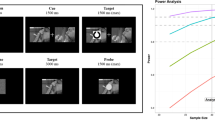Abstract
Rationale
According to recent theories of addiction, nicotine deprivation may influence biases in the orienting and maintenance of attention on smoking-related cues.
Objectives
We examined the effect of nicotine deprivation on different aspects of attentional biases for smoking-related cues.
Methods
Smokers’ eye movements to smoking-related and control pictures were assessed during a visual probe task under deprived and non-deprived conditions.
Results
When deprived, smokers maintained their gaze for longer on smoking-related than control cues, relative to when non-deprived. Deprivation also increased craving and pleasantness ratings of smoking cues. Across both deprived and non-deprived conditions, smokers were more likely to shift their gaze towards smoking cues and were faster to respond to probes replacing smoking cues, relative to non-smoking cues, but these attentional bias measures were not significantly affected by the deprivation manipulation.
Conclusions
Results suggest a selective effect of deprivation on the maintenance of attention on smoking-related cues.


Similar content being viewed by others
Notes
Results of the stimulus–response compatibility task will not be discussed as they were confounded by the order in which participants completed deprived and non-deprived sessions. Details of this task and the results are available on request from the authors.
The use of a 3 SD cut-off was applied to the dwell time and manual RT data, which is consistent with cut-offs used in previous research (Mogg et al. 2003).
References
Allport A (1989) Visual attention. In: Posner MI (ed) Foundations of cognitive science. MIT Press, Cambridge, pp 631–682
Bindra D (1974) A motivational view of learning, performance, and behavior modification. Psychol Rev 81:199–213
Bradley BP, Mogg K, Wright T, Field M (2003) Attentional bias in drug dependence: vigilance for cigarette-related cues in smokers. Psychol Addict Behav 17:66–72
Cox LS, Tiffany ST, Christen AG (2001) Evaluation of the brief questionnaire of smoking urges (QSU-brief) in laboratory and clinical settings. Nicotine Tob Res 3:7–16
Ehrman RN, Robbins SJ, Bromwell MA, Lankford ME, Monterosso JR, O’Brien CP (2002) Comparing attentional bias to smoking cues in current smokers, former smokers, and non-smokers using a dot-probe task. Drug Alcohol Depend 67:185–191
Gross TM, Jarvik ME, Rosenblatt MR (1993) Nicotine abstinence produces context-specific stroop interference. Psychopharmacology 110:333–336
Heatherton TF, Koslowski LT, Frecker RC, Fagerstrom KO (1991) The Fagerstrom test for nicotine dependence: a revision of the Fagerstrom tolerance questionnaire. Br J Addict 86:1119–1127
Hogarth L, Dickinson A, Duka T (2003a) Discriminative stimuli that control instrumental tobacco-seeking by human smokers also command selective attention. Psychopharmacology 168:435–445
Hogarth LC, Mogg K, Bradley BP, Duka T, Dickinson T (2003b) Attentional orienting towards smoking-related stimuli. Behav Pharmacol 14:153–160
Jonides J (1981) Voluntary versus automatic control over the mind’s eye movements. In: Long J, Baddeley A (eds) Attention and performance IX. Elrbaum, Hillsdale, pp 187–203
Kowler E (1995) Eye movements. In: Kosslyn SM, Osheron DM (eds) Visual cognition. Harvard University Press, Cambridge, pp 215–265
LaBerge D (1995) Attentional processing. Harvard University Press, Cambridge
McNair DM, Lorr M, Droppleman LF (1981) Manual for the profile of mood states. Educational and Industrial Testing Service, San Diego
Mogg K, Bradley BP (2002) Selective processing of smoking-related cues in smokers: manipulation of deprivation level and comparison of three measures of processing bias. J Psychopharmacol 16:385–392
Mogg K, Bradley BP, Field M, De Houwer J (2003) Biases in eye movements to smoking-related cues in smokers: relationship to affective and motivational valence. Addiction 98:825–836
Posner MI, Snyder CR, Davidson BJ (1980) Attention and the detection of signals. J Exp Psychol Gen 109:160–174
Robinson KC, Berridge TC (1993) The neural basis of drug craving: an incentive-sensitization theory of addiction. Brain Res Rev 18:247–291
Robinson KC, Berridge TC (2001) Incentive-sensitization and addiction. Addiction 96:103–114
Sayette MA, Hufford MR (1994) Effects of cue exposure and deprivation on cognitive resources in smokers. J Abnorm Psychol 103:812–818
Sayette M, Shiffman S, Tiffany ST, Niaura RS, Martin CS, Shadel WG (2000) The measurement of drug craving. Addiction 95[Suppl 2]:S189–S210
Schneider W (1995) MEL professional user’s guide. Psychology Software Tools, Pittsburgh
Schuh KJ, Stitzer ML (1995) Desire to smoke during spaced smoking intervals. Psychopharmacology 120:289–295
Tiffany ST (1990) A cognitive model of drug urges and drug-use behaviour: role of automatic and non-automatic processes. Psychol Rev 97:147–168
Waters AJ, Feyerabend C (2000) Determinants and effects of attentional bias in smokers. Psychol Addict Behav 14:111–120
Zack M, Belsito L, Scher R, Eissenberg T, Corrigall WA (2001) Effects of abstinence and smoking on information processing in adolescent smokers. Psychopharmacology 153:249–257
Acknowledgements
This work was supported by a grant from the Wellcome Trust to Brendan Bradley and Karin Mogg (ref. 057076). Karin Mogg holds a Wellcome Senior Research Fellowship in Basic Biomedical Science.
Author information
Authors and Affiliations
Corresponding author
Rights and permissions
About this article
Cite this article
Field, M., Mogg, K. & Bradley, B.P. Eye movements to smoking-related cues: effects of nicotine deprivation. Psychopharmacology 173, 116–123 (2004). https://doi.org/10.1007/s00213-003-1689-2
Received:
Accepted:
Published:
Issue Date:
DOI: https://doi.org/10.1007/s00213-003-1689-2




